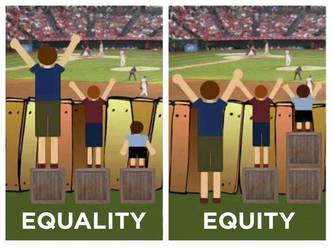 Equality vs Equity Equality vs Equity Since Serrano v. Priest established that California’s property-tax dependent finance system violated the 14th Amendment to the US Constitution and the Education Clause of the California Constitution, the school finance system has slowly become more equitable. According to Duzyk (2014) the state and local funds that combine to make up a district revenue limits attempt to create equal amount of per pupil funding, but basic aid districts are able to use their extra property taxes to exceed their revenue limits. Even though the revenue limits attempt to make things equal, the wealth of basic aid districts gives their students an inequitable advantage. But the inequity does not just apply to funding sources; districts that receive state and local funds can create inequities in their schools by providing all students with the same supports, regardless of needs that may extend beyond academic skill levels. One type of this population is foster youth. “Mandates” are necessary in order to ensure that our school financial system provides equitable support for special populations. The students at my school, San Pasqual Academy (SPA), a residential high school for foster youth, have plenty of advocates: family court judges, county board of supervisors members, lawyers, Court Appointed Student Advocates, residential agency staff, teachers, mentors, and even biological family members. Even with these advocates, the middle schoolers who live on our campus and attend school off campus at San Pasqual Union (SPU) in the Escondido School District have struggled to thrive at the neighborhood school. However, the relationship between SPA students and SPU has been changing over the past year and the students are succeeding at SPU. Many of our eighth graders are now considering promoting to the off-campus high school down the street with their non-foster youth peers, instead of eagerly leaving to return to the safety of SPA. The frictions between SPA students and SPU really seem to be improving. Of course, this is not just a sudden change of heart of the SPU community or change in the behaviors and academic skills of the SPA middle school students--it is about the money. According to An Overview of the Local Control Funding Formula (2013), under Local Control Funding Formula, “each EL/LI student and foster youth in a district generates an additional 20 percent of the qualifying student’s adjusted grade–span base rate.” SPA’s racially-diverse middle school students who have the ability to easily disrupt class and bring down subgroup score percentages on No Child Left Behind Test are now suddenly valuable. But, this would not have happened unless a state mandate validated the needs of this special population. Due to circumstances beyond the control of any district, special populations, such as foster youth, require additional academic and emotional support to reach the same learning goals as privileged students. Since these groups of students are often challenging in classrooms and in test score reports, it may be easier for districts to ignore and push away these students instead of working to understand and address their needs. Mandates are necessary to ensure districts provide all students with equitable learning opportunities, especially the challenging students. (Original discussion post edited for publication.) References Duzyk, L. (2014, October 30). Budget Crisis. Retrieved June 7, 2015, from https://www.youtube.com/watch?v=C-dySrQwqn8&feature=youtu.be An Overview of the Local Control Funding Formula. (2013, December 8). Retrieved June 7, 2015, from http://lao.ca.gov/reports/2013/edu/lcff/lcff-072913.aspx
0 Comments
Leave a Reply. |
@npriesterEvidence of my learning from SDSU EDL 600 Principles of Educational Administration Archives
August 2015
Categories |
 RSS Feed
RSS Feed